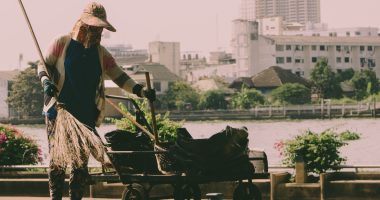Flake and farmed salmon should not make an appearance at your Good Friday fish feast.

Buying seafood in an environmentally responsible way can be so confusing that even top chefs require help.
“I actually couldn’t work out the sustainability of anything, so I took finned fish off the menu completely for two years,” Ben Shewry says.
The award-winning chef behind Melbourne’s Attica essentially stuck to mussels and oysters – filter feeders that clean our waterways – until he was certain of what to use. Nowadays, he can confidently cite the environmental credentials of the seafood on Attica’s menu, right down to the fish sauce used.
But his initial confusion shows why guidance is needed, and it’s inspired this article.
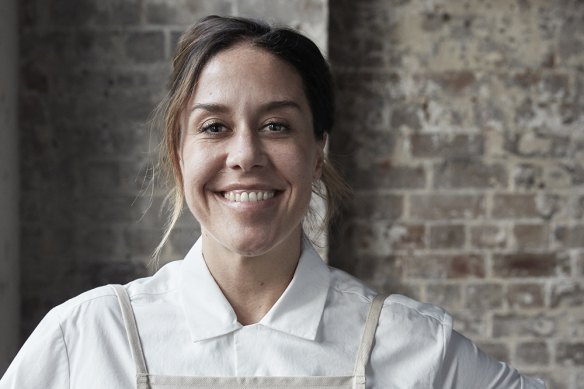
“It’s so difficult to get right,” Jacqui Challinor tells Good Food. The executive chef, who works across Melbourne and Sydney (Nomad, Beau, Reine & La Rue), recalls curing ocean trout at Nomad. That was before she realised it was red-listed on the Australian Marine Conservation Society’s GoodFish guide (goodfish.org.au) for its “serious negative environmental impacts” on Tasmania’s Macquarie Harbour, the remaining habitat of the endangered Maugean skate. So she switched to Ora King salmon from New Zealand – a product recommended by Seafood Watch and Ocean Wise.
“There’s a lot of complex information out there; no one’s going to be reading government reports that doesn’t have to,” Australian Marine Conservation Society’s Stephanie McGee says. It’s why the charity’s science-based GoodFish app and website exists. Launched in 2004 as the first fully independent reference for consumers, GoodFish now features over 90 per cent of the seafood available on the Australian market.
The guide uses various criteria (capture and management methods, stock health, environmental impact) to generate its traffic-stop ratings for seafood: red (“say no”), amber (“eat less”) and green (“better choice”). “I’ll always tend to jump on the website and just double-check what the right move is,” says Challinor, who uses it across her restaurants.
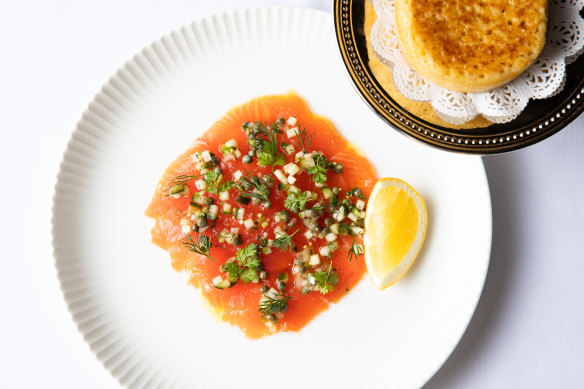
It’s handy because hard and fast rules don’t always apply. Sometimes an overseas product (such as salmon from New Zealand) has a better environmental impact than a local one; sometimes farmed species can be greener than wild-caught fish (see barramundi). Trawling can be detrimental to habitats and other species, but there are exceptions: see Spencer Gulf prawn fishery’s lower-impact approach. And the greener option can also depend on where you are. Take Spanish mackerel: GoodFish warns they’re “overfished or in unsustainable decline around Queensland and the Torres Strait”, while NT or WA-managed fisheries are worth buying from. “It’s a much healthier stock,” says McGee.
This science-driven approach contrasts to the prevalence of “greenwashing” (environmental claims that don’t stack up), which makes ethical shopping a brain-warping conundrum.
For instance, more than 80 organisations (including SeaChoice and Bob Brown Foundation) have called for sustainability certifications to be withdrawn from trout and salmon products farmed in Macquarie Harbour, and environmental groups have sent a complaint to the Australian Consumer and Competition Commission (ACCC), arguing it is “misleading” for supermarkets to sell Tasmanian farmed salmon with “responsibly sourced” claims.
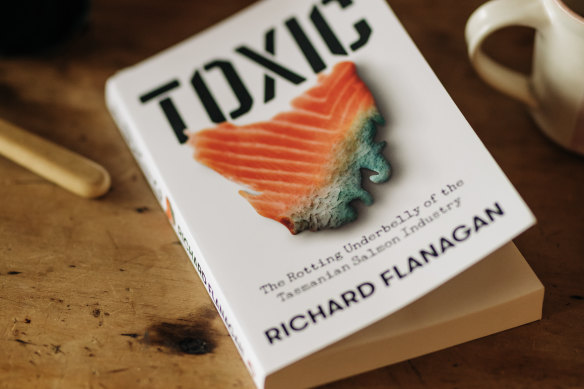
Richard Flanagan chronicles the devastating impact of this salmon production in his book Toxic, where he criticises animal welfare organisations (RSPCA, WWF) for their historical endorsement of the industry’s biggest players. A criminology paper by Paul Bleakley, of the University of New Haven, Connecticut, even questioned the financial connections between the farmed salmon trade and the certification bodies declaring their products sustainable.
GoodFish’s independence is why Shewry is the official ambassador for the app and guide. “It’s not backed by government or by big industry, and it doesn’t have any vested interests other than care for the planet – that’s what I love about it,” he explained on my Should You Really Eat That? podcast for SBS.
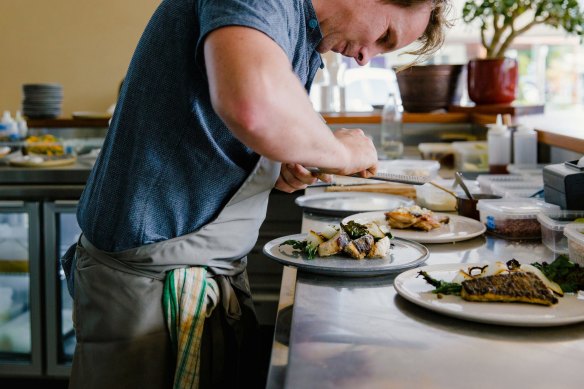
Chef Ben Devlin – who is so dedicated to sustainability that he turns fish bones into tableware and oyster shells into ceramic glazes with artist Leia Sherblom – shares this sentiment and pledges to only serve seafood recommended by the guide at his Pipit restaurant in Pottsville, northern NSW (he also avoids fish given the “red light”, so stocks can recover). “It’d be annoying if my daughter or hypothetical grandchildren … did not get the chance to eat them because we ate them all,” he says.
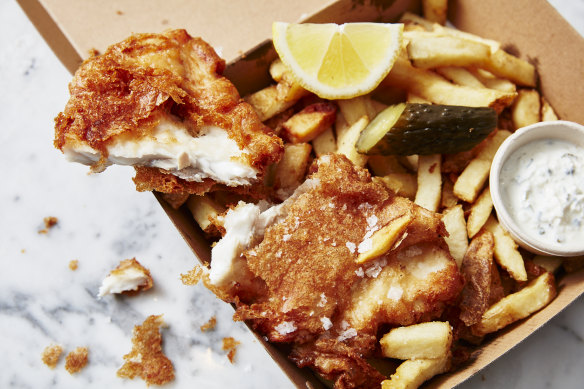
What to consider at the fish and chip shop
When people bite into flake at the fish and chip shop, they could be snacking on endangered shark. A University of Adelaide study revealed four kinds of threatened species (smooth hammerhead, shortfin mako, narrownose smooth-hound and school shark) could be served to customers requesting battered fish with chips. Poor labelling laws mean protected species are turning up on plates and in takeaway orders across the country.
“The problem is, you buy flake at the risk of eating hammerhead, grey nurse or [other species that should be protected],” says Lachlan Williams. As a scuba diver who has gone “eye to eye with a gummy shark at the bottom of the sea floor”, he’s especially passionate about this issue. On becoming head chef at Melbourne’s Cerberus Beach House last year, Williams removed flake and farmed Tasmanian salmon from the menu – replacing them with more sustainable choices such as barramundi from Infinity Blue, grown in thermal ponds across the bay. Despite the eco-friendly selection, kiosk staff still “get shouted at, on the daily” by customers who demand flake. But he believes it’s worth persisting with greener choices.
What to order: McGee recommends silver trevally from Victoria, calamari from jigged fisheries that target onlysquid (from Victoria, Western Australia or South Australia); Devlin recommends sand whiting from NSW, while Williams champions pink snapper from Port Phillip Bay, Portarlington mussels, Infinity Blue barramundi and rock flathead from Corner Inlet. “They only bring up rock flathead and if they bring up something else, then it goes back into water,” he says. In place of flake, Williams suggests trying line-caught mulloway from South Australia. “Mulloway is an excellent substitution for shark. It’s the same density and meatiness of fish that people expect.”
What to avoid: Flake and frozen/imported foods (65 per cent of our seafood comes from overseas, with little transparency about its origin). Devlin is sceptical of frozen calamari rings and prawn cutlets. “They’re imported from somewhere else, which means they’re probably not following particularly stringent sustainability guidelines.” He also suggests skipping basa, which is red-listed by GoodFish: it’s typically sourced from Vietnamese fisheries that are “highly unsustainable”, the guide warns.
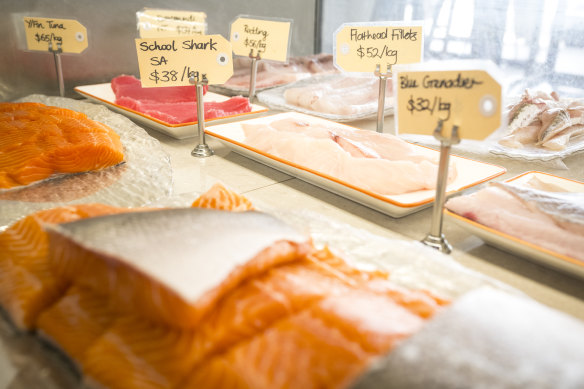
What to consider at the fishmonger
McGee is a fan of farmed barramundi (“it’s a better product than the gill-net-caught barramundi”), as is Sashim Bhetwal, a Nepalese-born chef about to open Sita by Sashim in Melbourne. “Its controlled environment ensures freshness and supports responsible farming,” he says. The fish’s mild taste complements the Nepalese flavours he works with. “Using it on my menu balances taste, quality and environmental consciousness,” he says. You can try making his spiced barramundi with no wastage broth and karkalla from GoodFish’s free cookbook (alongside recipes from Shewry and other chefs, available from GoodFish’s site).
What to buy: McGee suggests Australian herring, King George whiting (“always a safe bet”), snapper in certain regions (check GoodFish for details), and Spencer Gulf prawns. Challinor looks out for local, line-caught fish and recommends buying whole fish instead of fillets, to save money and reduce waste. Devlin says Ora King salmon from New Zealand is “widely recommended” as a sustainable pick if available.
What to avoid: Orange roughy (which can live for an astonishing 250 years), bluefin tuna (which is still endangered, despite increased stocks), and farmed Tasmanian salmon. Among other well-documented issues, the salmon industry is reportedly having a huge impact on a local skate species that has existed in Tasmanian waters since dinosaurs ruled the planet.
“No industrial seafood that is about to drive a unique species such as the Maugean skate to extinction is in any sense of the word ‘sustainable’,” says Flanagan.
“I’d encourage shops not to stock it, restaurants not to serve it and the reader to not eat it. Because when you eat Tasmanian salmon, you’re killing more of the wonder of my island home.”
From our partners
Read More: World News | Entertainment News | Celeb News
SMH




